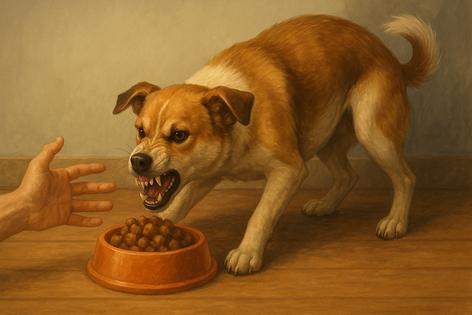Food Aggression in Dogs: Why it Happens and How to Safely Address It
Published in Cats & Dogs News
Food aggression in dogs can be startling for owners, especially when it appears suddenly in an otherwise gentle companion. But veterinarians and behaviorists say the behavior is common, highly manageable and usually rooted in fear rather than true hostility. Understanding why dogs guard food — and how to respond — can transform mealtimes from a source of tension into a predictable and peaceful routine.
What Food Aggression Looks Like
Food aggression, often called resource guarding, appears on a spectrum. In its mildest form, a dog becomes stiff or lowers its head protectively over a meal. In more serious cases, a dog may growl, snap or lunge if a person or another animal approaches while it eats.
While the behavior can seem domineering or defiant, experts emphasize that it is typically a fear-based response. Most dogs showing aggression around food are not trying to “be alpha” — they are worried about losing something important to them.
Why Dogs Guard Their Food
The roots of the behavior run deep. Canine ancestors lived in competitive environments where guarding resources was essential to survival. Even domestic dogs can revert to this instinct under stress.
Behaviorists point to several common triggers:
• Early-life competition, especially in large litters where puppies had to jostle for space at the bowl.
• Past experiences with food scarcity, especially in dogs rescued from neglect, hoarding or unstable homes.
• Stress in the household, including new pets, new babies or significant schedule changes.
• Medical issues, including pain, dental problems or digestive discomfort.
Dogs who suddenly begin guarding food after years of neutral behavior should receive a veterinary check to rule out illness or discomfort. Pain often makes animals more defensive.
Recognizing the Early Warning Signs
Resource guarding rarely begins with lunging. More often, dogs give subtle signals long before escalation occurs. Owners may notice rigid posture, a lowered head, a fixed stare or faster-than-usual eating when another person or pet is nearby.
These early signs matter. Intervening at this stage is far safer and more effective than trying to address full-blown aggression.
What Not to Do
One of the most persistent myths about food aggression is that it must be “corrected” through dominance. Trainers strongly warn against this approach. Grabbing a bowl, yelling, pushing a dog aside or physically challenging it can increase fear, worsen aggression and erode trust.
Punishment may stop a behavior in the moment but often creates more intense guarding later.
Safety First: Protecting People and Pets
When a dog has shown any level of food aggression, safety becomes the first priority. Owners should set up feeding spaces where the dog can eat undisturbed — behind a baby gate, in a quiet room, or in a crate if the dog finds that comfortable.
Children should never approach a dog while it eats, regardless of the dog’s history. Even friendly dogs can react unpredictably if startled during meals.
Positive Approaches That Work
Modern training focuses on reducing fear and building confidence rather than enforcing dominance. Behaviorists recommend gradual desensitization — teaching a dog that people approaching the bowl is a good thing, not a threat.
A common method involves tossing something better than the food already in the bowl — a small piece of chicken or cheese — from a safe distance, then walking away. Over time, owners can step slightly closer before tossing the treat.
The goal is to replace anxiety with anticipation. When a dog learns, “People coming near my food means better things appear,” guarding begins to fade.
Hand-Feeding as a Confidence Builder
Some dogs benefit from temporary hand-feeding. This practice teaches that food comes directly from the owner in a calm, predictable way. It is not about establishing dominance; it is about creating a positive association between humans and meals.
Over several days or weeks, owners can transition from hand-feeding to placing small portions in the bowl, gradually rebuilding trust around feeding rituals.
Managing Multi-Dog Homes
Food aggression becomes more complex when multiple dogs share a space. Even animals that get along well can struggle when meals are involved.
Behaviorists generally advise feeding dogs separately to avoid tension. Dogs should not have to compete for food or fear that another pet will invade their space. Separate bowls, separate rooms or staggered feeding times can significantly reduce stress.
Understanding Guarding of High-Value Items
Food aggression doesn’t always appear around meals. Dogs may guard bones, chew treats or even empty bowls. High-value items activate the same instinctive response: “I need to protect this because it matters.”
Owners can use similar training strategies with these items, exchanging them for something better, reinforcing the idea that surrendering a resource leads to rewards rather than loss.
When to Seek Professional Help
While mild resource guarding is manageable at home, more severe cases benefit from guidance from a certified trainer or veterinary behaviorist. Professionals can tailor a desensitization plan, ensure safety and help identify underlying triggers.
Dogs exhibiting sudden, intense or escalating aggression should be evaluated quickly — especially if there are children in the home.
The Role of Feeding Routines
Predictability eases anxiety. Dogs who know when mealtime is coming feel less pressure to guard resources. Routine also helps identify changes in behavior that might signal stress or illness.
Keeping meals consistent — same time, same place, same bowl — can reduce uncertainty and encourage calm eating habits.
Using Slow Feeders and Enrichment Bowls
For dogs who eat too quickly or show tension during meals, slow feeders can help reduce stress. These bowls contain ridges or patterns that make eating more deliberate and controlled.
The slower pace may ease feelings of competition, especially in households with multiple pets.
Helping Rescue Dogs Adjust
Many rescue dogs arrive with complicated histories. Some have survived genuine scarcity. Others lived in environments where food was unpredictable or competitors were common.
Patience is essential. Behaviorists say the transition from scarcity to abundance can take months. Dogs must unlearn survival instincts before they can relax around food.
Owners can help by establishing gentle, reliable routines and avoiding any actions that might trigger fear.
The Human Role: Staying Calm and Consistent
Dogs often mirror the energy around them. Owners who remain calm during feeding and avoid sudden movements or loud interruptions create a reassuring environment.
Consistency builds trust. When dogs understand that their food is secure — and that their humans are not threats — guarding behavior typically diminishes.
Why Food Aggression Is Not a Moral Failing
Experts emphasize that food aggression is a behavior, not a character flaw. Dogs do not guard food because they are “mean,” “spiteful” or “dominant.” They do so because something in their environment or past has taught them to worry.
With patience, structure and positive reinforcement, most dogs can learn to feel safe and relaxed around meals.
Supporting Dogs Through Change
Life changes — moves, new pets, new partners, newborns — can temporarily increase guarding behaviors. Owners may notice old habits resurfacing during times of instability.
Returning to established routines, reinforcing calm behavior and giving dogs space during meals often helps them readjust quickly.
Building a Peaceful Mealtime Culture
Ultimately, addressing food aggression is about more than managing a single behavior. It is about creating a household environment where dogs feel secure, understood and protected.
When fear decreases, trust grows. When trust grows, guarding fades. With the right approach, even the most tense mealtime patterns can become predictable moments of calm.
========
This article was written, in part, utilizing AI tools.









Comments